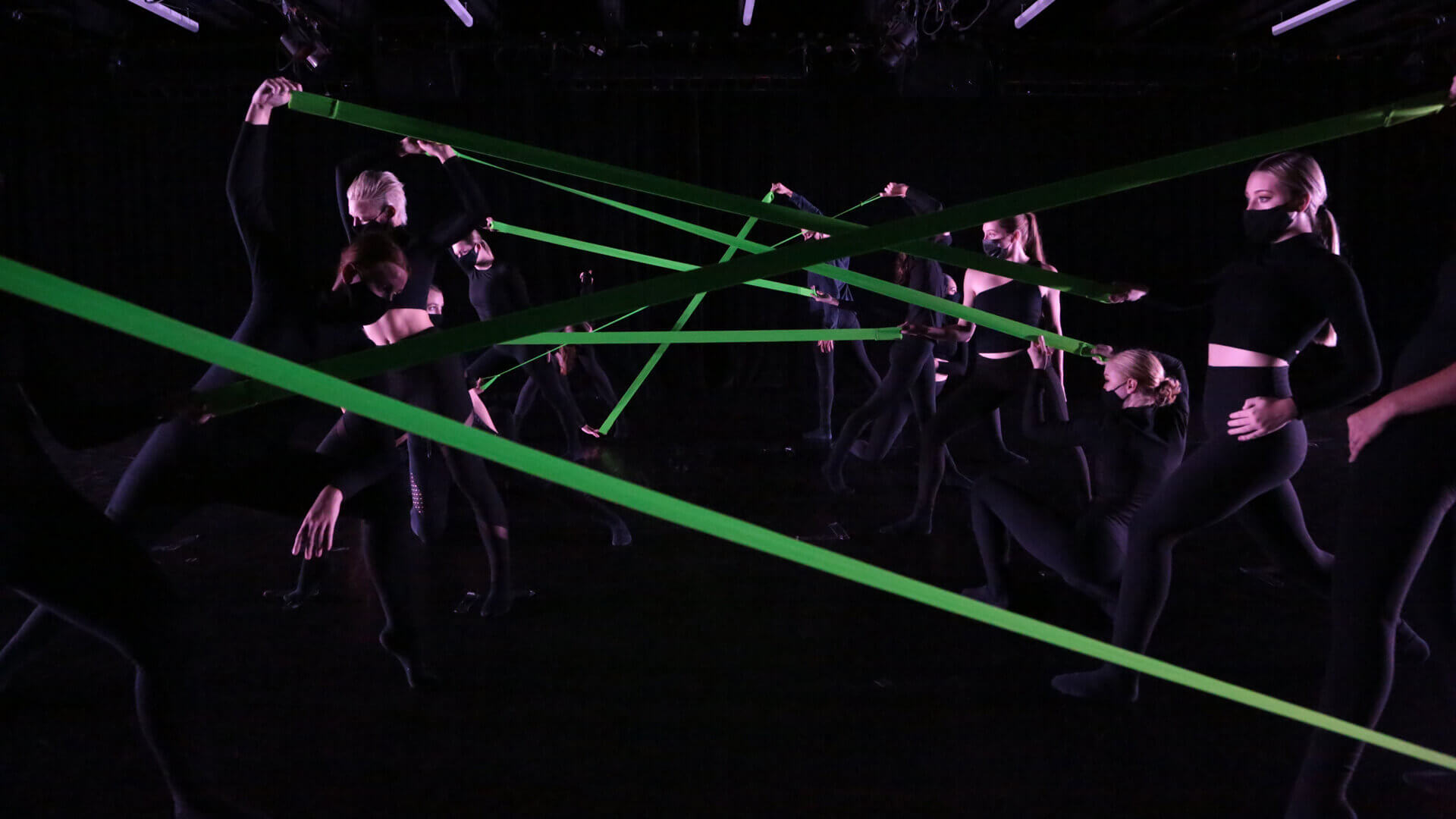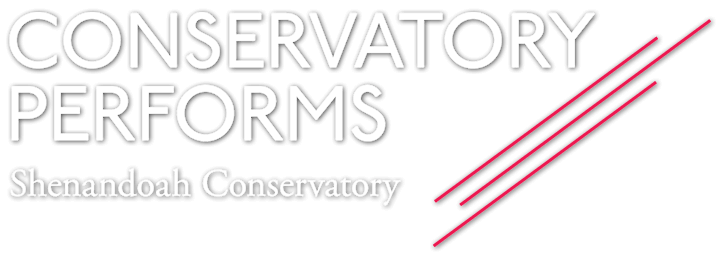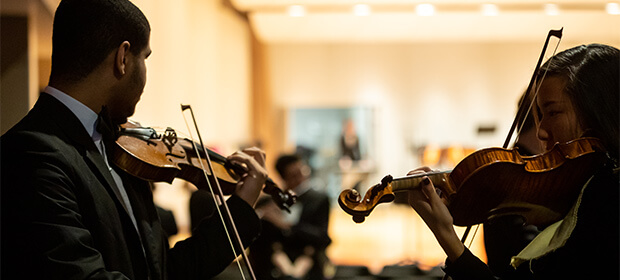‘Causal Effect’: The Road To Live Virtual Performances
Reflections on Crafting a Virtual Live Dance Concert in the Age of COVID-19

by Tiffanie Carson, choreographer, “Causal Effect”
“Causal Effect: A Virtual Revival” was livestreamed on Shenandoah University’s YouTube channel at 7 p.m. and 8 p.m. on Friday, Nov. 13 and Saturday, Nov 14. The performances featured 32 dance students and a mix of live and pre-recorded material. “Causal Effect” premiered at Shenandoah Conservatory in 2013.
Fall of 2020 will be and has been the most trying semesters of my career in academia for obvious reasons. From day one I, like many fellow colleagues in education, wanted to make sure my students could receive the best education possible, even in the virtual world and with hybrid learning. In terms of devices and electronics, the first step was fine-tuning operating all things Zoom, sound, space and time (a.k.a. the Zoomiverse and how it does not like to play well with performance art). The second was producing a live virtual concert. It was a huge priority for me to give the students a LIVE component this semester no matter what it would take. I was fortunate to experience performing in a live virtual concert during quarantine, and although it was not the traditional way to perform, the thrill, adrenaline and satisfaction were all there. I can tell you that producing this concert has been one of the most “fly by the seat of your pants” experiences of my life. As a planner and perfectionist, it is extremely jarring to experience constant changes while learning how to adapt, react and readapt on the fly, minute by minute. The plan was: set the piece, film it in parts to make a dance film in conjunction with the live component, and produce live performances.
With the genius work of Mike Esperanza and his ability to learn and figure out performances from home for BARE Dance Company’s performances over the summer, I asked if he could help stream our live performances in November the way we knew — using OBS (Open Broadcast Software) and Zoom. Mike could broadcast from New York City and the dancers were on campus; we would only need Wi-Fi. Easy enough, right?
With 32 dancers, I had planned to have the dancers all over campus and before convening at the top of the parking garage so all 32 dancers could be together with plenty of social distancing But, I had not thought ahead about how cold it would be (oops . . . too many things on the brain). Okay, no problem, I thought — we can move everything into Shingleton Dance Space. The Wi-Fi is stronger there, and although we’ll all be in closer proximity, everyone can still use their own phones, and we’ll split the show into two casts with 16 dancers each.
Because Mike is a virtual magician and always willing to go the extra mile to produce his art (p.s. have you seen the things he’s done since quarantine began?), he was willing to share what he’d learned about a livestream switcher that he plans on utilizing for the upcoming BARE Dance Company show (coming soon on Saturday, Dec. 5 – save the date). The switcher allows you to stream cleanly via HDMI cables from cameras (iPhones for us) and Ethernet. Lucky for me, he was willing to come and do practice runs with the switcher with my Shenandoah Conservatory dance students. We started with the idea of using eight cameras, as Mike planned on getting a switcher for eight. During the week I had planned to map out eight zones for eight cameras (iPhones), our department had to go online only. Of course, right? Perfect timing – thanks, coronavirus. At this point, we were three weeks out from performance dates. We had just finished a filming day of getting all the recorded footage and the next step was to prepare it for the live performances. So even though I couldn’t be in the studio with students, I went into Shingleton Dance Space and mapped everything out – Winchester roomie Miss Virginia Dot Kelly ’18, ’22 (Bachelor of Fine Arts in Dance, Master of Science in Performing Arts Leadership & Management) was invaluable for her help and devices. All 32 dancers hopped onto Zoom and I showed them each setup. The next step was to write the script of the show and the order of everything. But another change emerged — we had to switch to four cameras. The eight-camera switcher was too expensive (and Mike is not a millionaire). Okay, no problem — we could change to four cameras and use two different angles for each camera. Everything is hardwired into the switcher, so all HDMI cables (75 feet) need to reach up to the booth, meaning that dancers can’t be too far away. Writing and rewriting the script became a puzzle, requiring the balancing of two casts of 16 solo and eight duet moments each (and each cast is different in terms of material generated). I also had to find the royalty-free music I needed for the show because I wasn’t about to let copyright stop the show in the middle of it. There was also a camera app Mike had found that could help us adjust exposure and color for the feed so each of the students’ phones had to buy the app (don’t worry I Venmo’d each of them). Each of the tripods holding the phones needed a cell phone adapter, too, so I had to be sure to purchase those as well (luckily, our studios were equipped with plenty of tripods). I also had to edit the pre-recorded footage for intros and a filler in the middle of the performance. Lots of moving parts!
During the week of the show the dancers and I practiced running through the script trying to simulate the stream and script as closely as possible — a couple times just walking and talking through and another actually on Zoom so I could simulate which cameras were live when. We weren’t going to know what the real deal entailed until Mike could be there with the switcher. And I have to mention one more important detail that ended up being a game changer — Mike found out how to connect the drone to the switcher! This was the Tuesday of the performance week. I did buy myself a drone in September (2020 tax write-offs here I come) so we could connect my drone to his new controller (yes, a new controller in addition to the one he already has for his drone . . . somebody give this man money to produce art!). So now we had one camera that could FLY and move around the space. Score! (a.k.a. I started panicking, hoping not to run into anything . . . except I did, but it was a stationary pole . . . don’t worry, no drones including Mel the Mavik (the drone) were harmed in the making of this show . . . maybe one scratch on a wing . . . she’s fine!).
Mike arrived on Thursday of show week and we had less than two hours to fit in two dress rehearsal runs with each cast. Of course we all know that setup takes the longest so that was our biggest hurdle. Once we got everything up and running (phew!) the next thing was for me to call the show. No, I did not have a production crew nor a stage manager. I did have some help with lighting — shoutout to Maggie DeFrees ’23 (Bachelor of Arts in Dance)! The students in opposite casts were their own crew and I called the show in addition to flying the drone. Calling the show was one of the most nerve-wracking experiences. I had to call the dancers’ GO, Mike’s camera movement’s GO and fly the drone, which had two angles, so I had to make sure I turned the drone when needed. And, of course, there are all the things you learn when you’re going live the first time: the prerecorded videos that play from a phone need to be cued up then when switched back to the camera app, exposures and settings need to be adjusted again, my calling needed to be more fine tuned so that the changing of camera angles weren’t seen, the color and drone settings were drastically different than the phones and were too dark for one of the performances, etc. I have to say our first three runs were a bit rough and mistakes were made, but of course we learned from each time we ran the show. By the time we got to our final two performances it felt much better. I think if we had just one more night of performances we would have felt even better. That’s almost always the case, isn’t it?
I have never experienced anything quite like this, but it was definitely within the theme of just “go with it and make it work!” The dancers were absolute troopers and I can’t thank them enough for being so patient and open during the entire process, not to mention the STELLAR performing and mesmerizing creativity. I also had an amazing assistant by my side who always knew when to anticipate my needs and literally kept me from falling over. Shoutout to Cassidy Myers ’22 (Bachelor of Fine Arts in Dance) for all you did and do for me. And finally to the one person who made this all possible and who I’m calling ‘Mike the Magician’ — endless THANK YOUs for always bringing innovation and creativity into my life. I am but a tiny reflection of what you do. You will always be my inspiration. I’m so grateful to have you in my life for 22 years now!
If you made it through this entire post I thank you for supporting this venture and this work. Please do take a moment to watch this while it’s still available to view. Many thanks to all who did and reached out! It is so deeply appreciated. 💜
[one_half]
Cast A
[/one_half] [one_half_last]
Cast B
[/one_half_last]
– Reflections by Adjunct Assistant Professor of Dance Tiffanie Carson, M.F.A.


